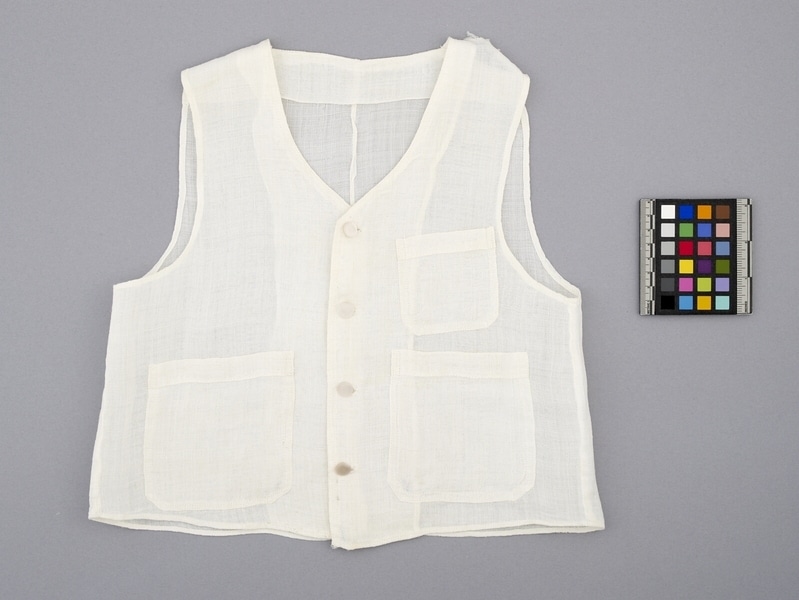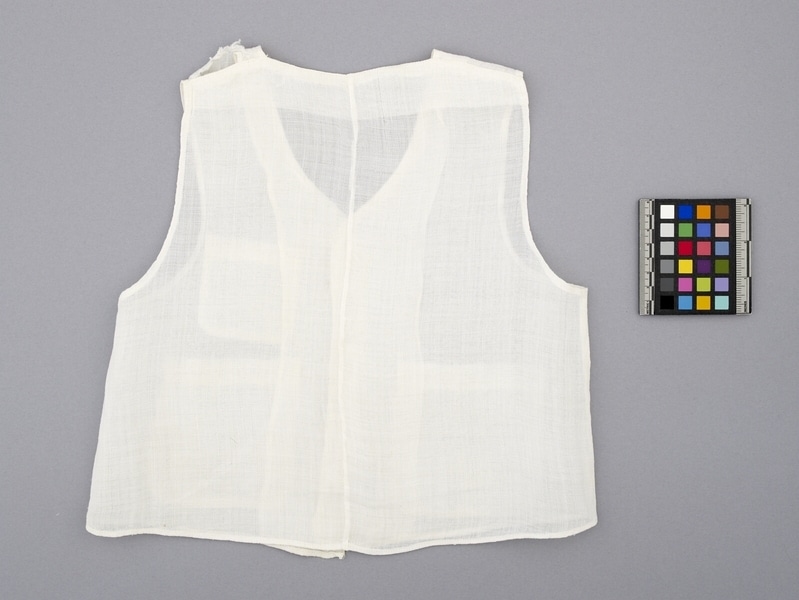Boy's Vest Item Number: Ed1.331 from the MOA: University of British Columbia


Description
Child’s vest of fine white ramie, closing at the centre front with four shank buttons made of white plastic. There are two pockets applied to the outside of the vest near the lower edge, and a smaller one on the upper left side. The lower edge of the vest curves downwards to the centre front. Vertical seam at the centre back.
History Of Use
Vests in western style began to be widely used in the 1930s, when they became popular. This reflected western influence in Korea after the opening of Korea to the outside world in the late 19th century. Before the 1930s, boys wore longer sleeveless vests called “Bae-ja”, which fastened with a cord at underarm level and tied at the centre front. The pockets and buttons also reflect western influence, the pockets reflecting the pouches formerly used to carry small items and the buttons replacing the ribbon ties formerly used. Full outside pockets appeared later than inset pockets. Vests of ramie were worn as upper body wear with jackets, “Jo-go-ri”, in summer, or as single upper body garments by rural boys. Well made vests of such fine fabric were not worn by boys from poor families. Vests worn by men normally have five buttons, while those worn by boys have four.
Specific Techniques
The fabric was hand-woven. The sewing was done by machine except for the button holes, which were hand-sewn. No raw edges are present; all edges are either selvedge or sewn in enclosed seams.
Narrative
Worn by Mark Elrod as a boy, while living with his family in Korea. Most of the clothing in the J. McRee Elrod Collection was made for him and his family by friends while they were living in Korea, much of it by Kim, Sung Sook. She and her family lived cooperatively in the same house as the Elrod family. While they were there, the Elrods preferred to wear Korean clothing on very cold days and for social occasions. They found it to be more comfortable than western clothing in cold weather, as public buildings were unheated in the period immediately following the Korean War. It also was more comfortable for floor seating in Korean homes, and easier to store with limited furniture than western clothing.
Item History
- Made by Sung Sook Kim (Maker) in Seoul, Korea between 1955 and 1960
- Collected between 1955 and 1960
- Owned by Mark Elrod
- Owned by J. McRee Elrod before October 13, 1976
- Received from J. McRee Elrod (Donor) on October 13, 1976
What
- Name
- Boy's Vest
- Identification Number
- Ed1.331
- Type of Item
- vest
- Material
- ramie fibre, cotton fibre and plastic
- Manufacturing Technique
- spun, woven, cut and sewn
- Overall
- height 36.5 cm, width 38.2 cm
Who
- Culture
- Korean
- Creator
- Sung Sook Kim (Maker)
- Previous Owner
- Mark Elrod and J. McRee Elrod
- Received from
- J. McRee Elrod (Donor)
Where
- Holding Institution
- MOA: University of British Columbia
- Made in
- Seoul, Korea
When
- Creation Date
- between 1955 and 1960
- Collection Date
- between 1955 and 1960
- Ownership Date
- before October 13, 1976
- Acquisition Date
- on October 13, 1976
Other
- Item Classes
- textiles
- Condition
- good
- Accession Number
- 0335/0012